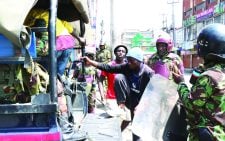Considered a fad, Bitcoin now hits $100k milestone

In May 2010, Laszlo Hanyecz, an early cryptocurrency enthusiast, used Bitcoin to buy two pizzas from Papa John’s. He spent 10,000 Bitcoins, or roughly $40 at the time, in one of the first purchases ever made with the digital currency.
It has turned out to be the most expensive dinner in history.
On Wednesday, the price of a single Bitcoin rose to more than $100,000, a remarkable milestone for an experimental financial asset that had once been mocked as a sideshow and a fad. The total cost of those pizzas today: $1 billion.
Bitcoin now stands as arguably the most successful investment product of the past 20 years. The value of all the coins in circulation is $2 trillion, more than the combined worth of Mastercard, Walmart and JPMorgan Chase.
Trump, Bitcoin enthusiast?
The motley assortment of hackers and political radicals who embraced Bitcoin when it was created by an anonymous coder in 2008 have become millionaires many times over.
And the invention has spawned an entire industry anchored by publicly traded companies such as Coinbase, a cryptocurrency exchange, and promoted by celebrities, athletes and Elon Musk.
Even the president-elect says he is a believer. During the campaign, Donald Trump marketed himself as a Bitcoin enthusiast, vowing to create a federal stockpile that could push its price even higher.
Bitcoin began as “essentially an experimental hobbyist project,” said Finn Brunton, author of a 2019 book about the history of cryptocurrency. “To see where it is now is to see a really impressive feat.”
Bitcoin’s rise to $100,000 signals its now-undeniable status in the global economic system. The virtual currency has become a staple of financial markets, embraced by Wall Street giants and amateur investors alike. Its surge also caps an astonishing turnaround after its price dropped below $17,000 in 2022, as the collapse of the FTX crypto exchange sent the industry into a tailspin.
This year, Bitcoin has come roaring back. Federal regulators allowed Wall Street firms to offer a popular financial product tied to the coin, attracting billions of dollars in fresh investment. Then, Trump’s election victory sent its price even higher, as crypto enthusiasts branded him the first “Bitcoin president.”
Strong advocate for loser regulations
Last month, Gary Gensler, chair of the Securities and Exchange Commission and a crypto critic who had led a crackdown on the industry, said he would step down Jan. 20.
Earlier Wednesday, Trump picked Paul Atkins, a former regulator and founder of a financial consulting firm, as the next SEC leader. He has advised clients on crypto issues, and is seen as a strong advocate for looser regulation of the digital asset industry.
In a matter of months, Bitcoin investors went from bemoaning tough regulation under the Biden administration to shopping for Lamborghinis and gloating on social media. Top crypto executives spent about $135 million to influence the U.S. election, and they are now enjoying the spoils.
“There’s an enormous amount of excitement in the industry right now,” said Jeremy Allaire, the CEO of Circle, an influential U.S. crypto company. “A lot of positive energy.”
Still, Bitcoin remains prone to extreme volatility. Its price sometimes drops when the global economy struggles. Environmental groups have raised concerns that the energy required to run Bitcoin’s software contributes to climate change, and the technology has long been used by scammers and thieves.
While some of that illicit activity has fallen off, cybercriminals used digital currencies to facilitate about $500 million in ransom payments over the first six months of the year, according to crypto forensics firm Chainalysis.
Before it became a cultural and financial phenomenon, Bitcoin was just an idea sketched out in a nine-page white paper posted on an internet mailing list on Halloween in 2008. The author was a mysterious coder who used the pseudonym Satoshi Nakamoto.
At its most basic, Satoshi’s vision was a type of digital money that people could exchange without relying on banks to process the transfers. Every transaction would be recorded on a publicly visible ledger known as a blockchain.
Early enthusiasts envisioned Bitcoin as the foundation for a new kind of financial system that would be governed by code and exist outside the supervision of Wall Street firms and government regulators.
They also viewed Bitcoin as a long-term store of value — it was programmed to have a fixed supply, so it would be resistant to inflation.
The Wall Street establishment dismissed Bitcoin as a passing trend and a tool for criminals. Jamie Dimon, CEO of JPMorgan Chase, called Bitcoin “a fraud” and a “Ponzi scheme.” Trump once decried it as “a scam” designed to undermine the U.S. dollar.














